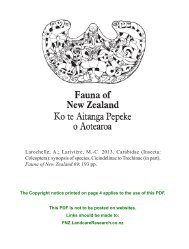Fauna of NZ 45 - Landcare Research
Fauna of NZ 45 - Landcare Research
Fauna of NZ 45 - Landcare Research
You also want an ePaper? Increase the reach of your titles
YUMPU automatically turns print PDFs into web optimized ePapers that Google loves.
28 Kuschel (2003): Nemonychidae, Belidae, Brentidae (Insecta: Coleoptera)<br />
flying at other times <strong>of</strong> the day. Larvae live in dead twigs<br />
and branches.<br />
Remarks. Agathinus is closely related to the Australian<br />
Cyrotyphus Pascoe from which it differs in having shallow,<br />
not engraved frontal grooves, hemispherical eyes, stretched<br />
head with temples twice the length <strong>of</strong> an eye diameter,<br />
elytra that broaden considerably through to the apical quarter,<br />
and tibiae that lack mucro in both sexes. It comprises a<br />
single species.<br />
Etymology. ‘Agáthinus’: from the Greek adjective ágathos<br />
meaning excellent, refined, aristocratic, and the suffix -inus;<br />
gender masculine.<br />
Agathinus tridens (Fabricius)<br />
Fig. 6, 52, 84–91, 175, 185–187; Map 9<br />
Fabricius, 1787: 122 (Curculio); 1792: 483 (Curculio); 1801:<br />
537 (Curculio). —Gmelin, 1790: 1774 (Curculio). —<br />
Olivier, 1790: 555 (Curculio); 1807: 403, pl. 13, fig.<br />
154 (Curculio). —Herbst, 1795: 520, pl. 85, fig. 5<br />
(Curculio). —Latreille, 1797: pl. 233, fig. 5 (Curculio).<br />
—Boisduval, 1835: <strong>45</strong>8 (Curculio). —Broun, 1880: 471.<br />
—Sharp, 1884: 298 (syn. sextuberculatus). —Lea, 1909:<br />
8, fig. 11. —Hudson, 1934: 146, pl. 13, fig. 4. —Kuschel,<br />
1970: 196. —Styles, 1973: 352 (host plants <strong>of</strong> larva). —<br />
May, 1993: 38, fig. 196–207 (larva).<br />
sextuberculatus White, 1846: 13, pl. 3, fig. 8 (Rhinaria). —<br />
Broun, 1880: 471.<br />
Reddish brown to black. Vestiture dense, concealing almost<br />
completely integument, consisting mostly <strong>of</strong> lineal<br />
or lanceolate scales, greyish white or yellowish grey, brown<br />
in part on tubercles or forming variegated dots or spots<br />
(Fig. 6). Other features as in the generic description.<br />
Length: 7.5–14.5 (–15.7) mm.<br />
Types. 1) Curculio tridens:Holotype &, 15.7 x 6.5 mm, no<br />
locality, in Banks Coll., BMNH; an unusually large specimen<br />
almost certainly collected at Ship Cove, Queen Charlotte<br />
Sound in Cook Strait, South Island.<br />
2) Rhinaria sextuberculata: Holotype %, 11.7 x 4.8 mm,<br />
Wellington, Mr Earl, BMNH.<br />
Material examined. 2 Holotypes and 164 non-type specimens.<br />
North Island. ND. Kaitaia. AK. Waitakere Range.<br />
CL. Little Moehau Peak, Mt Moehau; Mt Moehau;<br />
Kennedy Bay Rd. BP. Mt Te Aroha. TO. Waituhi Saddle;<br />
Raurimu; Waimarino; Whakapapaiti Valley, Tongariro NP;<br />
Tongariro NP; Whakapapa, Ruapehu; Chateau, Ruapehu;<br />
Ohakune Mtn Rd; Blyth Track, Ohakune; Mangawhero,<br />
Ohakune Mtn Rd; Waikato Valley, Kaimanawas. GB. L.<br />
Waikaremoana; Makahu Spur, Kaweka Range. TK.<br />
Ahukawakawa Track, Pouakai Range; Pouakai Range; Holly<br />
Hut, North Egmont; Mt Egmont. WN. Tokomaru Gorge;<br />
Otaki Gorge; Wharite, South Ruahine; Mt Hector; Mt<br />
Holdsworth, Tararuas; Tararuas; Dundas Hut Ridge,<br />
Tararua Range; Bainham; Kaitoke; Akatarawa; Korokoro;<br />
Silverstream; Wellington. South Island. SD. Croisilles.<br />
NN:Dun Mtn; Ruby Bay; Gordon’s Pyramid; Riwaka;<br />
Riwaka Valley; Takaka Hill; Top <strong>of</strong> Trig K, Canaan; Mt<br />
Arthur; Salisbury Opening, Mt Arthur; Balloon Hut, Mt<br />
Arthur; Gouland Downs; Cobb Valley; Mt Domett; Quartz<br />
Range, W Nelson; Brown Cow Ridge; Mt Stewart;<br />
Karamea. BR. L. Rotoiti; Travers Valley; Lewis Pass;<br />
Rahu Saddle; Mawhera SF; Sewell Pk, Paparoa Range; 1.6<br />
km S <strong>of</strong> 4-Mile Ck, Charleston; Moana. WD. Mahinapua<br />
SF. 166 specimens — see Appendix 2 for details <strong>of</strong> specimens<br />
examined.<br />
Distribution. ND, AK, CL, BP, TO, GB, TK, WN / SD,<br />
NN, BR, WD.<br />
Host plant. Adults are associated with Phyllocladus<br />
(Phyllocladaceae), Dacrydium, Halocarpus, Podocarpus,<br />
and Prumnopitys species (Podocarpaceae), but larvae develop<br />
in dead, usually non-coniferous wood, such as<br />
Cassinia and Olearia (Asteraceae), Coprosma (Rubiaceae),<br />
Corokia (Cornaceae), Cyathodes (Epacridaceae), Gaultheria<br />
(Ericaceae), and Hebe (Scrophulariaceae).<br />
Remarks. A. tridens is one <strong>of</strong> the most distinctive species<br />
<strong>of</strong> the New Zealand fauna amongst weevils with straight,<br />
non-geniculate antennae because <strong>of</strong> the presence <strong>of</strong> a large<br />
preapical callus produced over the elytral sides across the<br />
top <strong>of</strong> the declivity. Both specific names refer to three<br />
large raised structures present on each elytron <strong>of</strong> the species.<br />
Aralius Kuschel<br />
Fig. 7, 92–99, 177, 179, 184<br />
Kuschel, 1990: 79 (replacement name for Platycephala; typespecies<br />
P. olivieri Montrouzier).<br />
Platycephala Montrouzier, 1861: 268 (not Fallén 1820). —<br />
Paulian, 1944: 117.<br />
Head broad , across eyes broader than length from epistome<br />
to neck, strongly constricted behind eyes to a cylindrical<br />
neck. Frons nearly as wide as head, convex, lacking impression.<br />
Eyes strongly protruding, hemispherical or nearly<br />
so, coarsely facetted, with coarse interfacettal setae. Rostrum<br />
usually sexually conspicuously dimorphic, in male<br />
nearly twice as wide as long , with a transverse, medially
















